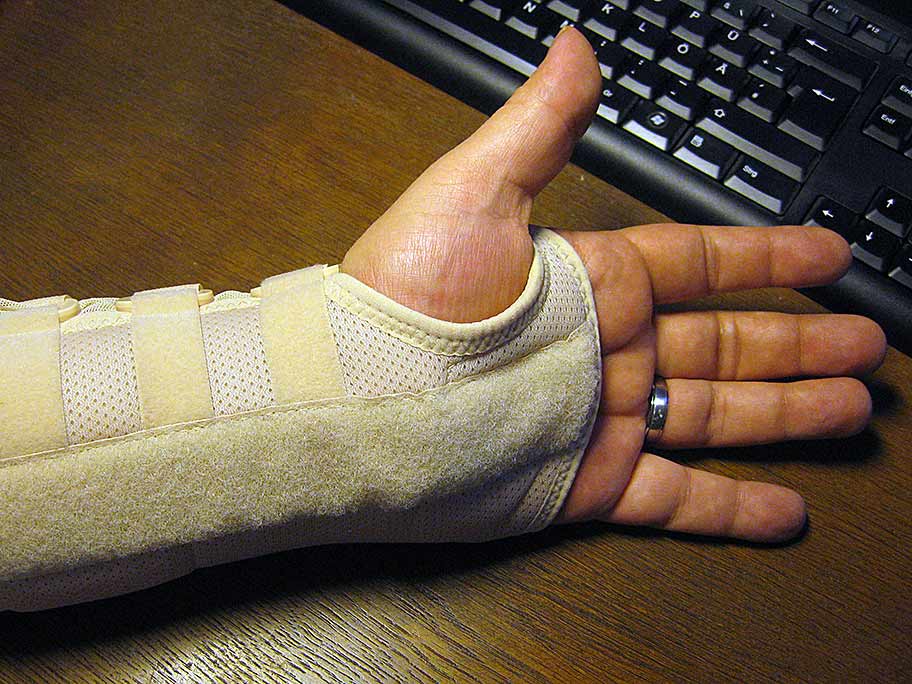
Ergonomics: How to protect your career from desk injuries
Part 1 in a series
Imagine coming to work and not being able to type a story on your keyboard because of intense pain in your wrist, elbow or fingers. It’s a scary thought. I never thought it could happen to me. I’m only 33 years old. But I’ve been suffering from tendonitis for several months. More than a year ago I began having pain in my left wrist periodically. But it usually came and disappeared within the same day. Then suddenly it became more noticeable, and gradually it became a constant companion. I love to write, but I almost dreaded coming to work because I didn’t want to be in pain. Like everyone I use my hands continually throughout the day, so it’s been a slow recovery process.
An ergonomic specialist reviewed my workstation and gave me suggestions for furniture that would help me become more ergonomic. She also suggested various assistive technology such as dictation to help alleviate some of the pain and give my wrist the rest it needed to recover.
But the pain will be worth it if I can help another person. I’m thankful I have a platform like the Reynolds Journalism Institute where I can help other journalists. I’ll share more about my experience in another post.
—JN
Journalists face a number of risks in their work. Sometimes it’s covering a dangerous news situation like a wildfire or a mass shooting. At other times, it’s a less obvious threat that lurks in the newsroom such as repetitive motion injuries brought on by or made worse by spending a long day in front of a computer.
But if journalists recognize the risk factors and take precautionary steps, they can greatly reduce the chances of being injured, say Columbia, Missouri, ergonomic specialists, two of which are also physical therapists.
Risk factors
There are factors that put people at risk, including awkward and static postures, which put strains on tissues and decrease blood supply to certain areas.
Frequent repetitive motions such as typing can also put a person at risk for conditions such as tendonitis or carpel tunnel syndrome.
“If you’re constantly moving and not allowing enough time for the blood and oxygen supply to come back to rejuvenate the muscles, you could potentially wear them down and fatigue them out to the point of injury,” says Dr. Bret Derrick, physical therapist and ergonomic specialist at Broadway Ergonomics in Columbia, Missouri.
Secondary risks can include contact stress where a worker rests a wrist on a hard corner of the desk, which can compress the body’s soft tissue and impair blood supply, he adds.
Emotional stress brought on by deadlines can increase stress hormones and also make people more susceptible to injuries, he says.
Some individuals are also more prone to suffer injuries including those who are obese, sedentary or smokers. Those who suffer from various health conditions such as diabetes, thyroid issues or autoimmune disorders can also be at greater risk, says Dr. Eric Schultz, physical therapist and economic specialist at Broadway Ergonomics.
“It’s usually a combination of risk factors that develop and to some degree, a perfect storm, and then all of a sudden the body has met its capacity and an injury occurs,” says Schultz.
Laptops and incompatible work stations
Not using ergonomic equipment or sitting at a workstation that’s not a good fit for your body also puts a person at risk.
Although office equipment has improved with more ergonomic options, laptop keyboards are still not ergonomic and are not meant to be used for multiple hours a day, says Derrick. Mobile devices are also a catalyst for ergonomic injuries.
“We are sacrificing ergonomics for mobility and portability,” says Derrick.
Holding a laptop in the lap means the user has to look down at the screen, which can cause neck strain. Placing a laptop on a higher surface can mean putting your arms and wrists in compromising positions that could result in injuries, too, says Schultz.
“You take it to the coffee shop and you’re there for an hour or two — that’s not going to hurt you,” says Schultz. “But if you’re working on it nonstop, that’s when you’re going to set yourself up for an issue.”
The repetition of hitting the mouse pad on laptops with the same finger can also cause discomfort, says Jennifer Thornhill, user support analyst at the University of Missouri’s Adaptive Computing Technology Center.
Thornhill evaluates workstations for faculty and staff. She makes recommendations and rents out ergonomic tools and assistive technology to folks to make sure people get the best fit for them, she says.
As she evaluates workstations, she says one of the most common mistake she sees is people reaching upwards and outwards for their mouse and keyboard. This is often caused because desks are too high for them. If they lean forward to reach for their keyboard or mouse, they sometimes use the muscles in their upper back and arms to support them, which can put too much strain on parts of the body if they do this all day, every day. Doing this can result in pain in the upper arms, neck and back, she says.
How to recognize an injury
Early detection is key and can help prevent pain from getting worse or becoming chronic. Watch for any signs of pain or discomfort whether it’s fatigue, swelling, numbness, tingling or shooting pains. Report pain right away to a manager, a company ergonomics specialist (if there is one) or doctor.
If your company doesn’t have an ergonomic department, ask them or a doctor for a referral.
How to prevent injuries
- Refer to an ergonomic checklist to make sure your workstation is comfortable and ergonomic for your body type.
“When a person gets a job, they often sit down at their desk and try to fit themselves into what was already set up,” says Thornhill. “With ergonomics, I try to set the desk up to fit the person.”
“When you look at most office setups, the desks are set for the tallest males, so the majority of people actually don’t fit well in the standard desk,” adds Schultz.
- Take regular breaks. If you need to, set your phone’s alarm to
remind you to get up and stretch or go for a quick walk around the
office.
Thornhill says not taking breaks is another common mistake she sees happening among workers. She recommends a five-minute break at least once an hour.
- Change tasks and positions when possible.
- Add ergonomic keyboards, external monitors and external mice to a laptop.
- Consider a sit-to-stand workstation, which provides users the opportunity to change positions and improve posture, says Derrick.
- Put down the mobile devices regularly. Switch between devices.
Type longer messages on ergonomic computer keyboards or dictate
messages rather than using tiny smartphone keyboards.
- Employers should make employees aware of ergonomic resources available to them. This can help prevent injuries and reduce costs to the employer. Have workstations reviewed by an ergonomic specialist when a new employee starts.
